engine coolant CADILLAC ESCALADE 2010 3.G Owners Manual
[x] Cancel search | Manufacturer: CADILLAC, Model Year: 2010, Model line: ESCALADE, Model: CADILLAC ESCALADE 2010 3.GPages: 616, PDF Size: 39.41 MB
Page 5 of 616
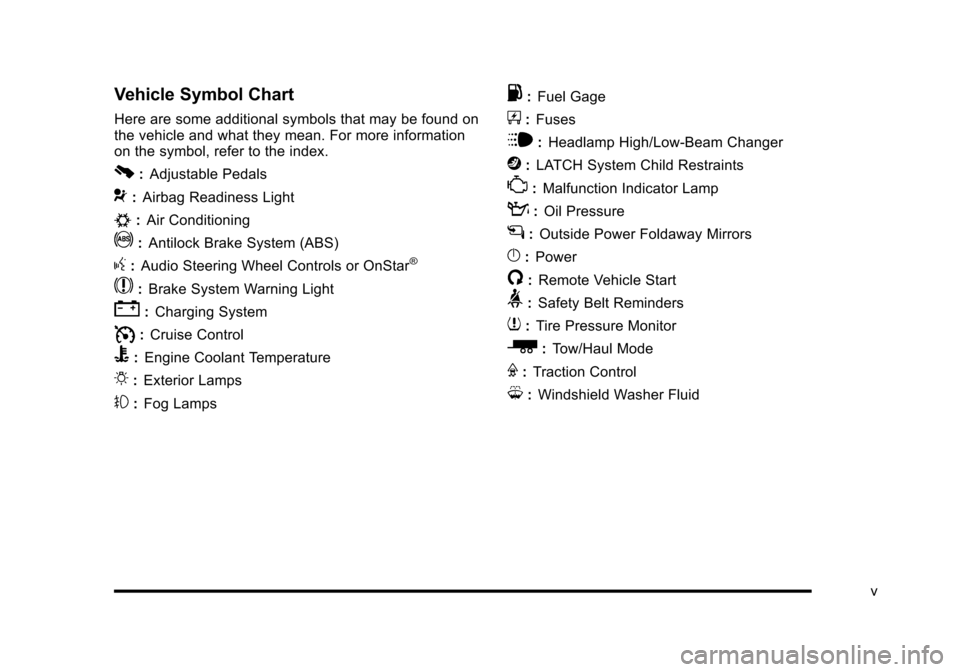
Vehicle Symbol Chart
Here are some additional symbols that may be found onthe vehicle and what they mean. For more informationon the symbol, refer to the index.
0:Adjustable Pedals
9:Airbag Readiness Light
#:Air Conditioning
!:Antilock Brake System (ABS)
g:Audio Steering Wheel Controls or OnStar®
$:Brake System Warning Light
":Charging System
I:Cruise Control
B:Engine Coolant Temperature
O:Exterior Lamps
#:Fog Lamps
.:Fuel Gage
+:Fuses
i:Headlamp High/Low-Beam Changer
j:LATCH System Child Restraints
*:Malfunction Indicator Lamp
::Oil Pressure
g:Outside Power Foldaway Mirrors
}:Power
/:Remote Vehicle Start
>:Safety Belt Reminders
7:Tire Pressure Monitor
_:Tow/Haul Mode
F:Traction Control
M:Windshield Washer Fluid
v
Page 125 of 616

Section 3 Features and Controls
Keys. . . . . . . . . . . . . . . . . . . . . . . . . . . . . . . . . . . . . . . . . . . . . . . . 3-3Remote Keyless Entry (RKE) System . . . . . . . . . . . 3-4Remote Keyless Entry (RKE) SystemOperation . . . . . . . . . . . . . . . . . . . . . . . . . . . . . . . . . . . . . 3-4Remote Vehicle Start . . . . . . . . . . . . . . . . . . . . . . . . . . . 3-7
Doors and Locks. . . . . . . . . . . . . . . . . . . . . . . . . . . . . . . . . 3-10Door Locks . . . . . . . . . . . . . . . . . . . . . . . . . . . . . . . . . . . . 3-10Power Door Locks . . . . . . . . . . . . . . . . . . . . . . . . . . . . . 3-10Delayed Locking . . . . . . . . . . . . . . . . . . . . . . . . . . . . . . . 3-11Programmable Automatic Door Locks . . . . . . . . . . 3-11Rear Door Security Locks . . . . . . . . . . . . . . . . . . . . . . 3-11Lockout Protection . . . . . . . . . . . . . . . . . . . . . . . . . . . . . 3-12Liftgate/Liftglass . . . . . . . . . . . . . . . . . . . . . . . . . . . . . . . 3-12Power Liftgate . . . . . . . . . . . . . . . . . . . . . . . . . . . . . . . . . 3-14Power Assist Steps . . . . . . . . . . . . . . . . . . . . . . . . . . . . 3-17
Windows. . . . . . . . . . . . . . . . . . . . . . . . . . . . . . . . . . . . . . . . . . 3-18Power Windows . . . . . . . . . . . . . . . . . . . . . . . . . . . . . . . 3-19Sun Visors . . . . . . . . . . . . . . . . . . . . . . . . . . . . . . . . . . . . . 3-21
Theft-Deterrent Systems. . . . . . . . . . . . . . . . . . . . . . . . . 3-22Content Theft-Deterrent . . . . . . . . . . . . . . . . . . . . . . . . 3-22PASS-Key®III+ Electronic Immobilizer . . . . . . . . . 3-24PASS-Key®III+ Electronic ImmobilizerOperation . . . . . . . . . . . . . . . . . . . . . . . . . . . . . . . . . . . . 3-24
Starting and Operating Your Vehicle. . . . . . . . . . . . 3-26New Vehicle Break-In . . . . . . . . . . . . . . . . . . . . . . . . . . 3-26Ignition Positions . . . . . . . . . . . . . . . . . . . . . . . . . . . . . . 3-27Retained Accessory Power (RAP) . . . . . . . . . . . . . 3-28Starting the Engine . . . . . . . . . . . . . . . . . . . . . . . . . . . . 3-29Adjustable Throttle and Brake Pedal . . . . . . . . . . . 3-30Engine Coolant Heater . . . . . . . . . . . . . . . . . . . . . . . . . 3-31Active Fuel Management™. . . . . . . . . . . . . . . . . . . . 3-32Automatic Transmission Operation . . . . . . . . . . . . . 3-32Tow/Haul Mode . . . . . . . . . . . . . . . . . . . . . . . . . . . . . . . . 3-36Parking Brake . . . . . . . . . . . . . . . . . . . . . . . . . . . . . . . . . 3-38Shifting Into Park . . . . . . . . . . . . . . . . . . . . . . . . . . . . . . 3-39Shifting Out of Park . . . . . . . . . . . . . . . . . . . . . . . . . . . . 3-40Parking Over Things That Burn . . . . . . . . . . . . . . . . 3-41Engine Exhaust . . . . . . . . . . . . . . . . . . . . . . . . . . . . . . . . 3-41Running the Vehicle While Parked . . . . . . . . . . . . . 3-42
3-1
Page 133 of 616

For example, if the lock button and then the remote startbuttons are pressed again after the vehicle has beenrunning for five minutes, 10 minutes are added, allowingthe engine to run for 15 minutes.
The additional ten minutes are considered a secondremote vehicle start.
After your vehicles engine has been started two timesusing the remote vehicle start button, or a single remotestart with one time extension, the vehicle must bestarted with the key.
After the key is removed from the ignition, the vehiclecan be remote started again.
The vehicle cannot be remote started if the key is inthe ignition, the hood is not closed, or if there is anemission control system malfunction and the checkengine light comes on.
Also, the engine will turn off during a remote vehiclestart if the coolant temperature gets too high or if the oilpressure gets low.
Vehicles that have the remote vehicle start feature areshipped from the factory with the remote vehicle startsystem enabled. The system may be enabled ordisabled through the DIC. See“REMOTE START”underDIC Vehicle Customizationon page 4!57foradditional information.
3-9
Page 155 of 616

Engine Coolant Heater
The engine coolant heater can provide easier startingand better fuel economy during engine warm-up in coldweather conditions at or below!18°C (0°F). Vehicleswith an engine heater should be plugged in at leastfour hours before starting. An internal thermostat inthe plug-end of the cord may exist which will preventengine coolant heater operation at temperaturesabove!18°C (0°F).
To Use the Engine Coolant Heater
1. Turn off the engine.
2. Open the hood and unwrap the electrical cord.The cord is secured to the Engine CompartmentFuse Block with a clip. Carefully remove the wiretie which secures the electrical cord. Do not cut theelectrical cord.
3. Plug the cord into a normal, grounded 110-voltAC outlet.
{WARNING:
Plugging the cord into an ungrounded outlet could
cause an electrical shock. Also, the wrong kind of
extension cord could overheat and cause a fire.
You could be seriously injured. Plug the cord into
a properly grounded three-prong 110-volt AC
outlet. If the cord will not reach, use a heavy-duty
three-prong extension cord rated for at least
15 amps.
4. Before starting the engine, be sure to unplug andstore the cord as it was before to keep it away frommoving engine parts. If you do not, it could bedamaged.
The length of time the heater should remain plugged independs on several factors. Ask a dealer/retailer in thearea where you will be parking the vehicle for the bestadvice on this.
3-31
Page 194 of 616
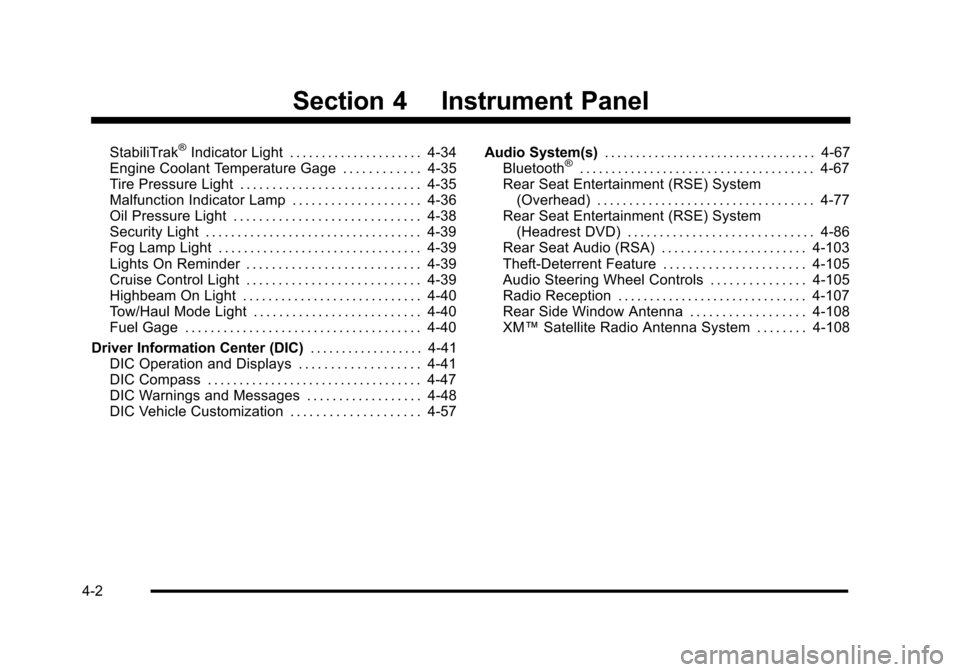
Section 4 Instrument Panel
StabiliTrak®Indicator Light . . . . . . . . . . . . . . . . . . . . . 4-34Engine Coolant Temperature Gage . . . . . . . . . . . . 4-35Tire Pressure Light . . . . . . . . . . . . . . . . . . . . . . . . . . . . 4-35Malfunction Indicator Lamp . . . . . . . . . . . . . . . . . . . . 4-36Oil Pressure Light . . . . . . . . . . . . . . . . . . . . . . . . . . . . . 4-38Security Light . . . . . . . . . . . . . . . . . . . . . . . . . . . . . . . . . . 4-39Fog Lamp Light . . . . . . . . . . . . . . . . . . . . . . . . . . . . . . . . 4-39Lights On Reminder . . . . . . . . . . . . . . . . . . . . . . . . . . . 4-39Cruise Control Light . . . . . . . . . . . . . . . . . . . . . . . . . . . 4-39Highbeam On Light . . . . . . . . . . . . . . . . . . . . . . . . . . . . 4-40Tow/Haul Mode Light . . . . . . . . . . . . . . . . . . . . . . . . . . 4-40Fuel Gage . . . . . . . . . . . . . . . . . . . . . . . . . . . . . . . . . . . . . 4-40
Driver Information Center (DIC). . . . . . . . . . . . . . . . . . 4-41DIC Operation and Displays . . . . . . . . . . . . . . . . . . . 4-41DIC Compass . . . . . . . . . . . . . . . . . . . . . . . . . . . . . . . . . . 4-47DIC Warnings and Messages . . . . . . . . . . . . . . . . . . 4-48DIC Vehicle Customization . . . . . . . . . . . . . . . . . . . . 4-57
Audio System(s). . . . . . . . . . . . . . . . . . . . . . . . . . . . . . . . . . 4-67Bluetooth®. . . . . . . . . . . . . . . . . . . . . . . . . . . . . . . . . . . . . 4-67Rear Seat Entertainment (RSE) System(Overhead) . . . . . . . . . . . . . . . . . . . . . . . . . . . . . . . . . . 4-77Rear Seat Entertainment (RSE) System(Headrest DVD) . . . . . . . . . . . . . . . . . . . . . . . . . . . . . 4-86Rear Seat Audio (RSA) . . . . . . . . . . . . . . . . . . . . . . . 4-103Theft-Deterrent Feature . . . . . . . . . . . . . . . . . . . . . . 4-105Audio Steering Wheel Controls . . . . . . . . . . . . . . . 4-105Radio Reception . . . . . . . . . . . . . . . . . . . . . . . . . . . . . . 4-107Rear Side Window Antenna . . . . . . . . . . . . . . . . . . 4-108XM™Satellite Radio Antenna System . . . . . . . . 4-108
4-2
Page 214 of 616
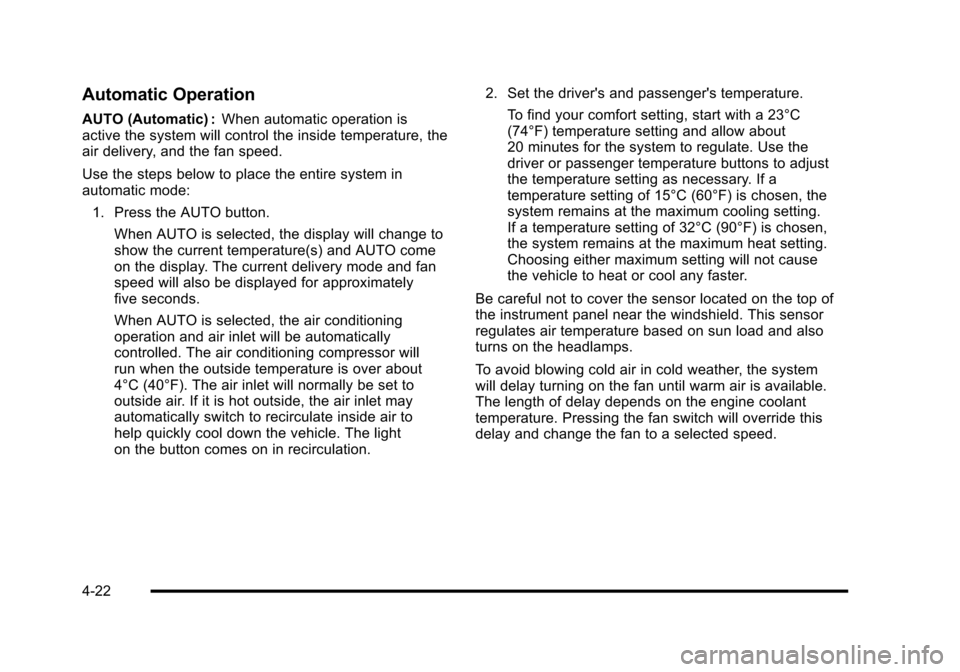
Automatic Operation
AUTO (Automatic) :When automatic operation isactive the system will control the inside temperature, theair delivery, and the fan speed.
Use the steps below to place the entire system inautomatic mode:
1. Press the AUTO button.
When AUTO is selected, the display will change toshow the current temperature(s) and AUTO comeon the display. The current delivery mode and fanspeed will also be displayed for approximatelyfive seconds.
When AUTO is selected, the air conditioningoperation and air inlet will be automaticallycontrolled. The air conditioning compressor willrun when the outside temperature is over about4°C (40°F). The air inlet will normally be set tooutside air. If it is hot outside, the air inlet mayautomatically switch to recirculate inside air tohelp quickly cool down the vehicle. The lighton the button comes on in recirculation.
2. Set the driver's and passenger's temperature.
To find your comfort setting, start with a 23°C(74°F) temperature setting and allow about20 minutes for the system to regulate. Use thedriver or passenger temperature buttons to adjustthe temperature setting as necessary. If atemperature setting of 15°C (60°F) is chosen, thesystem remains at the maximum cooling setting.If a temperature setting of 32°C (90°F) is chosen,the system remains at the maximum heat setting.Choosing either maximum setting will not causethe vehicle to heat or cool any faster.
Be careful not to cover the sensor located on the top ofthe instrument panel near the windshield. This sensorregulates air temperature based on sun load and alsoturns on the headlamps.
To avoid blowing cold air in cold weather, the systemwill delay turning on the fan until warm air is available.The length of delay depends on the engine coolanttemperature. Pressing the fan switch will override thisdelay and change the fan to a selected speed.
4-22
Page 227 of 616
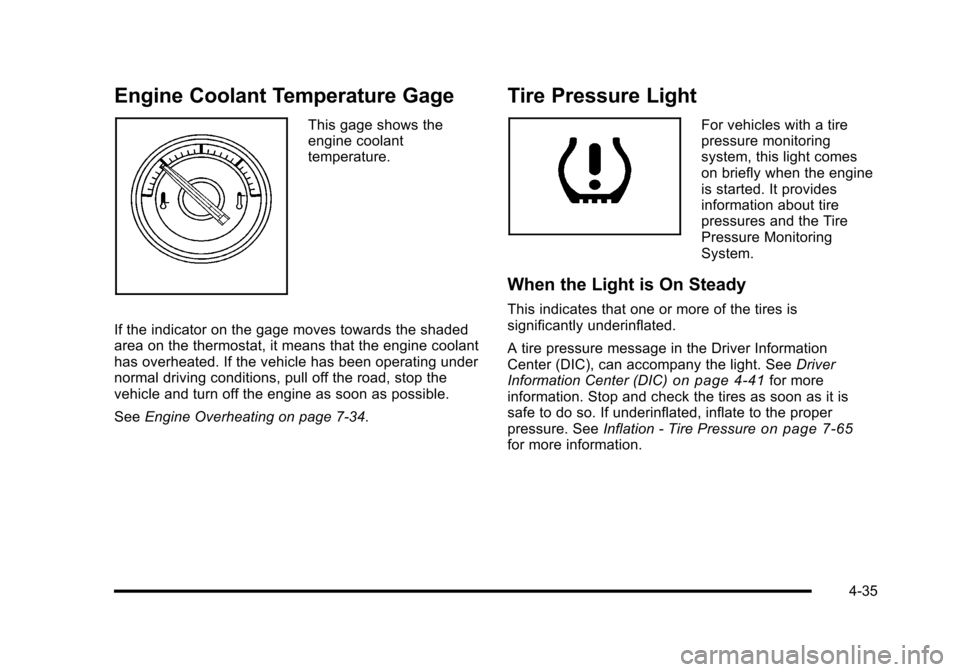
Engine Coolant Temperature Gage
This gage shows theengine coolanttemperature.
If the indicator on the gage moves towards the shadedarea on the thermostat, it means that the engine coolanthas overheated. If the vehicle has been operating undernormal driving conditions, pull off the road, stop thevehicle and turn off the engine as soon as possible.
SeeEngine Overheating on page 7!34.
Tire Pressure Light
For vehicles with a tirepressure monitoringsystem, this light comeson briefly when the engineis started. It providesinformation about tirepressures and the TirePressure MonitoringSystem.
When the Light is On Steady
This indicates that one or more of the tires issignificantly underinflated.
A tire pressure message in the Driver InformationCenter (DIC), can accompany the light. SeeDriverInformation Center (DIC)on page 4!41for moreinformation. Stop and check the tires as soon as it issafe to do so. If underinflated, inflate to the properpressure. SeeInflation - Tire Pressureon page 7!65for more information.
4-35
Page 241 of 616
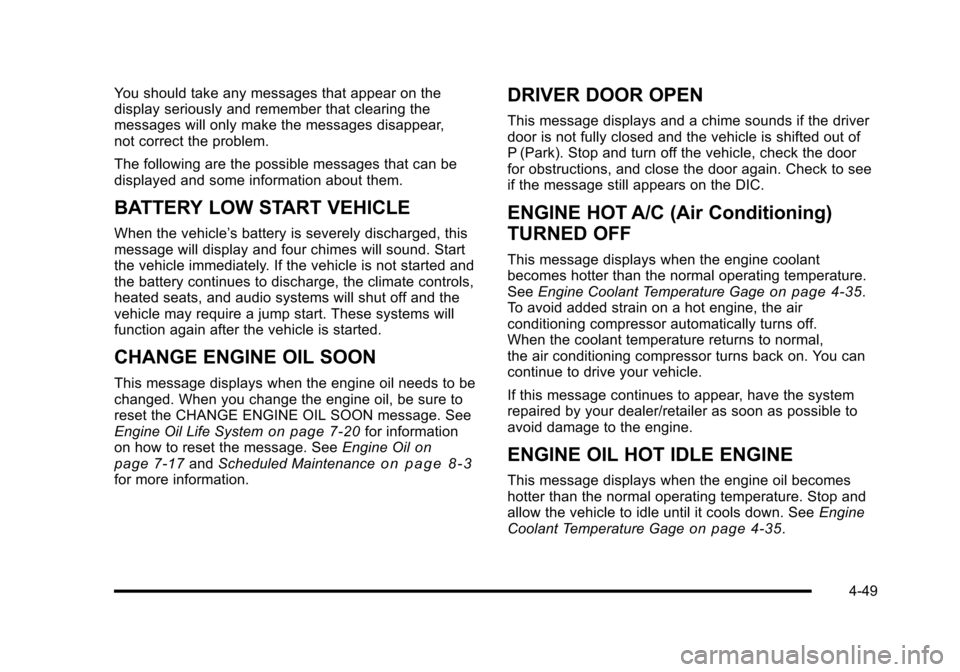
You should take any messages that appear on thedisplay seriously and remember that clearing themessages will only make the messages disappear,not correct the problem.
The following are the possible messages that can bedisplayed and some information about them.
BATTERY LOW START VEHICLE
When the vehicle’s battery is severely discharged, thismessage will display and four chimes will sound. Startthe vehicle immediately. If the vehicle is not started andthe battery continues to discharge, the climate controls,heated seats, and audio systems will shut off and thevehicle may require a jump start. These systems willfunction again after the vehicle is started.
CHANGE ENGINE OIL SOON
This message displays when the engine oil needs to bechanged. When you change the engine oil, be sure toreset the CHANGE ENGINE OIL SOON message. SeeEngine Oil Life Systemon page 7!20for informationon how to reset the message. SeeEngine Oilonpage 7!17andScheduled Maintenanceo n p a g e 8!3for more information.
DRIVER DOOR OPEN
This message displays and a chime sounds if the driverdoor is not fully closed and the vehicle is shifted out ofP (Park). Stop and turn off the vehicle, check the doorfor obstructions, and close the door again. Check to seeif the message still appears on the DIC.
ENGINE HOT A/C (Air Conditioning)
TURNED OFF
This message displays when the engine coolantbecomes hotter than the normal operating temperature.SeeEngine Coolant Temperature Gageon page 4!35.To avoid added strain on a hot engine, the airconditioning compressor automatically turns off.When the coolant temperature returns to normal,the air conditioning compressor turns back on. You cancontinue to drive your vehicle.
If this message continues to appear, have the systemrepaired by your dealer/retailer as soon as possible toavoid damage to the engine.
ENGINE OIL HOT IDLE ENGINE
This message displays when the engine oil becomeshotter than the normal operating temperature. Stop andallow the vehicle to idle until it cools down. SeeEngineCoolant Temperature Gageon page 4!35.
4-49
Page 242 of 616

ENGINE OVERHEATED IDLE ENGINE
Notice:If you drive your vehicle while the engine isoverheating, severe engine damage may occur. If anoverheat warning appears on the instrument panelcluster and/or DIC, stop the vehicle as soon aspossible. SeeEngine Overheatingon page 7!34formore information.
This message displays when the engine coolanttemperature is too hot. Stop and allow the vehicle toidle until it cools down. SeeEngine CoolantTemperature Gage on page 4!35.
SeeOverheated Engine Protection Operating Modeonpage 7!37for information on driving to a safe place inan emergency.
ENGINE OVERHEATED STOP ENGINE
Notice:If you drive your vehicle while the engine isoverheating, severe engine damage may occur. If anoverheat warning appears on the instrument panelcluster and/or DIC, stop the vehicle as soon aspossible. SeeEngine Overheatingon page 7!34formore information.
This message displays and a chime sounds if theengine cooling system reaches unsafe temperatures foroperation. Stop and turn off the vehicle as soon as it issafe to do so to avoid severe damage. This messageclears when the engine has cooled to a safe operatingtemperature.
ENGINE POWER IS REDUCED
This message displays and a chime sounds when thecooling system temperature gets too hot and the enginefurther enters the engine coolant protection mode.SeeEngine Overheatingon page 7!34for furtherinformation.
This message also displays when the vehicle's enginepower is reduced. Reduced engine power can affect thevehicle's ability to accelerate. If this message is on, butthere is no reduction in performance, proceed to yourdestination. The performance may be reduced the nexttime the vehicle is driven. The vehicle may be driven ata reduced speed while this message is on, butacceleration and speed may be reduced. Anytime thismessage stays on, the vehicle should be taken to yourdealer/retailer for service as soon as possible.
FUEL LEVEL LOW
This message displays and a chime sounds if the fuellevel is low. Refuel as soon as possible. SeeFuel Gageon page 4!40andFuelo n p a g e 7!7for moreinformation.
HOOD OPEN
This message displays and a chime sounds if the hoodis not fully closed. Stop and turn off the vehicle, checkthe hood for obstructions, and close the hood again.Check to see if the message still appears on the DIC.
4-50
Page 442 of 616
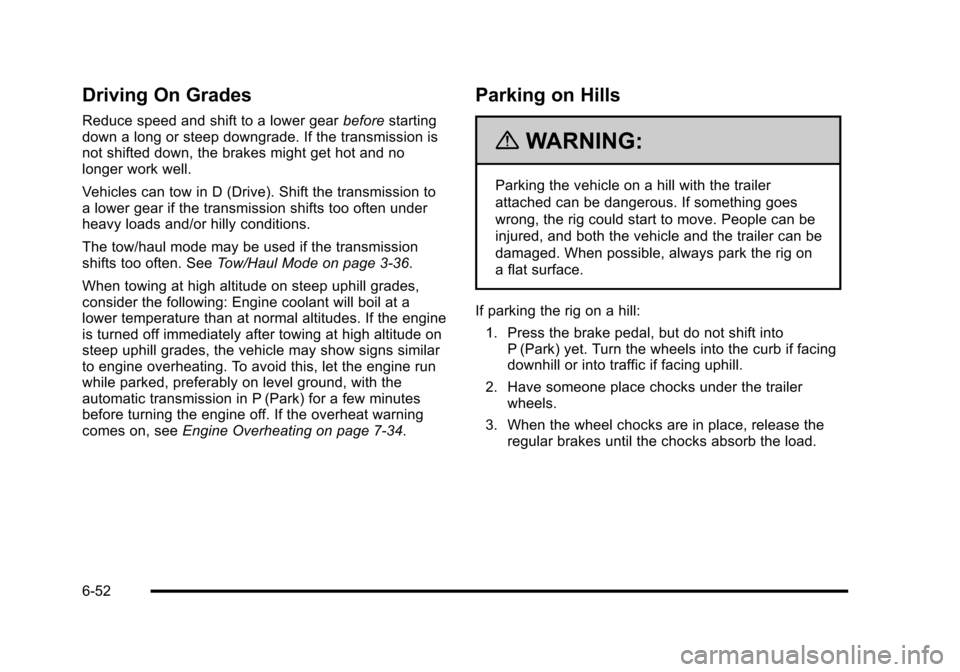
Driving On Grades
Reduce speed and shift to a lower gearbeforestartingdown a long or steep downgrade. If the transmission isnot shifted down, the brakes might get hot and nolonger work well.
Vehicles can tow in D (Drive). Shift the transmission toa lower gear if the transmission shifts too often underheavy loads and/or hilly conditions.
The tow/haul mode may be used if the transmissionshifts too often. SeeTow/Haul Mode on page 3!36.
When towing at high altitude on steep uphill grades,consider the following: Engine coolant will boil at alower temperature than at normal altitudes. If the engineis turned off immediately after towing at high altitude onsteep uphill grades, the vehicle may show signs similarto engine overheating. To avoid this, let the engine runwhile parked, preferably on level ground, with theautomatic transmission in P (Park) for a few minutesbefore turning the engine off. If the overheat warningcomes on, seeEngine Overheating on page 7!34.
Parking on Hills
{WARNING:
Parking the vehicle on a hill with the trailer
attached can be dangerous. If something goes
wrong, the rig could start to move. People can be
injured, and both the vehicle and the trailer can be
damaged. When possible, always park the rig on
a flat surface.
If parking the rig on a hill:
1. Press the brake pedal, but do not shift intoP (Park) yet. Turn the wheels into the curb if facingdownhill or into traffic if facing uphill.
2. Have someone place chocks under the trailerwheels.
3. When the wheel chocks are in place, release theregular brakes until the chocks absorb the load.
6-52